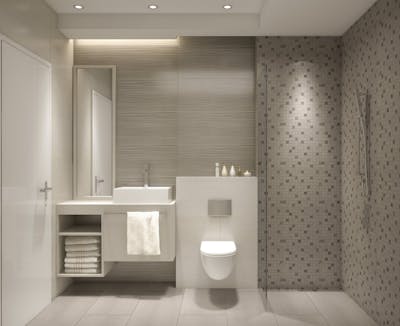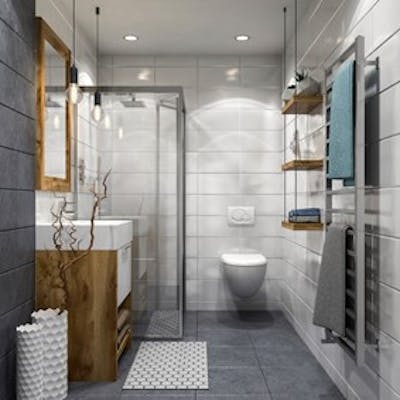Complete Guide to Wet Rooms & Wet Room Installation | More Bathrooms
Published: 22 August 2019
As full-service bathroom design and installation experts we are regularly asked about wet rooms and wet room ideas. With many misconceptions, especially around them leaking, we have created this helpful article to answer a handful of the most common questions.
With a focus on wet room installation we will cover a few wet room topics including:
> What is a wet room?
> Are wet rooms a good idea?
> Wet room advantages
> Wet room disadvantages
> Wet room Installation
> How to install a wet room?
> How to make a wet room watertight
> How to make your bathroom a wet room?
.jpg?auto=compress%2Cformat&cs=strip&ixlib=php-1.1.0&s=afdb35046eb0aef1ced360d19d500406)
What is a wet room?
We often get asked what is a wet room? To answer this quite simply a wet room is an open plan, watertight shower room.
The shower tends to be an open plan space. Meaning it does not include any patrician leading to the possibility of the entire room getting wet. With that said a shower screen or curtain can be incorporated into the design if preferred.
Another signature feature of a wet room is their level access design. Sunk into the floor, the shower tray is installed underneath the surface, tanked (covered in waterproof liquid)and the chosen flooring covering laid over the top.
Are wet rooms a good idea?
Wet rooms have massively grown in popularity in recent years, but they may not be the best showering solution for you. Below we have listed a few wet room advantages and disadvantages to consider;
Advantages of wet rooms
> Wet room shower areas blend seamlessly with the rest of the shower room, due to the open plan design.
> Wet rooms are a great option for small spaces with limited room. Within reason, there is no minimum size requirements to facilitate wet room installation.
> As shower screens are optional and the shower tray is non-visible, wet rooms are easier to clean than other shower room options. Especially if you also opt for wall board coverings and vinyl flooring as they have a ‘non grout’ requirement making wet rooms easy to maintain.
Disadvantages of wet rooms
> To help make a wet room waterproof tiles or wall boards are applied to the walls. This can be expensive in comparison to other shower options as you need to cover the entire room, rather than just the ‘focused’ shower area.
> If you have a small bathroom and don’t opt for a glass screen or shower curtain in your showering area it can lead to items such as toilet paper getting wet and soggy.
> You need to be extremely selective on who you contract to carry out your wet room instillation. A specialist project due to the ‘tanking’ requirement of your tray and flooring you need to ensure you’re in the right hands. Otherwise you may end up with water damage, as a result of a leak, if the installation is not done correctly. To speak to one of our experts for further advice on wet room installation Get in touch
![]()

Wet room Installation
The two most important factors of a successful wet room installation are water drainage and water proofing, both of which help to make your wet room watertight.
.jpg?auto=compress%2Cformat&cs=strip&ixlib=php-1.1.0&s=98612f178242ff33b75e664f3c3ee63c)
How to install a wet room?
What makes a wet room unique is the installation of a non-visible shower tray which is sunk into your floor offering a level access design.
Where floorboards are present these are removed to make room for the tray. In some instances, you may have a concrete floor which will need to be dug out to the same effect. Thetray is then fitted, tanked and covered. The rest of the shower room floor is covered with tiles or slip resistant vinyl, creating a level access shower area.
How to make a wet room watertight: Step 1 water drainage
Whilst installing the shower tray for your wet room, an area is also selected for drainage and incorporated into the wet room design. A gradual slope is created along the floor to encourage the water to run directly into the drain.
As mentioned above, the wet room floor is then covered with tiles or a non- slip vinyl to keep the floor watertight.
Underfloor heating is also recommended to help the water on your wet room floor dry quicker.
How to make a wet room watertight: Step 2 water proofing
Wet rooms need to be sealed and watertight. All walls and the floor are completely covered usually with tiles and vinyl or tiles and wallboards.
An impermeable membrane is also installed in-between the floor and your chosen covering for extra security and to protect the longevity of your wet room installation.
It is important to note that wet room installation must be done by an expert. The right flooring must also be selected to avoid water leakage and damage. For more information about our 5* rated full-service design and installation service Get in touch
.jpg?auto=compress%2Cformat&cs=strip&ixlib=php-1.1.0&s=e3e4fc66379991f65d34aeeef6e5ee7a)
How to make your bathroom a wet room?
We are often asked how to make a bathroom a wet room and as mentioned above it requires the adaptation or creation of an open plan showering concept. A relatively straight forward conversion. All existing fixtures will need to be removed, the whole bathroom waterproofed and tanked, and then the suite re-installed with the incorporation of a sunk shower tray and drainage.
Wet rooms that include baths are better suited to bigger bathrooms with enough space to include all bathroom amenities comfortably.
At More Bathrooms we understand what it takes to create a stunning wet room. If you wish to find out more about wet room installations take a look at our guides or Get in touch
Share this Post


.jpg?auto=compress%2Cformat&cs=strip&ixlib=php-1.1.0&s=afdb35046eb0aef1ced360d19d500406)

.jpg?auto=compress%2Cformat&cs=strip&ixlib=php-1.1.0&s=98612f178242ff33b75e664f3c3ee63c)
.jpg?auto=compress%2Cformat&cs=strip&ixlib=php-1.1.0&s=e3e4fc66379991f65d34aeeef6e5ee7a)


.jpg?auto=compress%2Cformat&cs=strip&fit=clip&h=400&ixlib=php-1.1.0&w=400&s=c80ddb61e006377b43ef4bfe9a05bfa8)

















